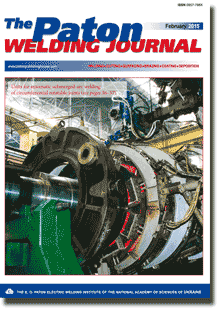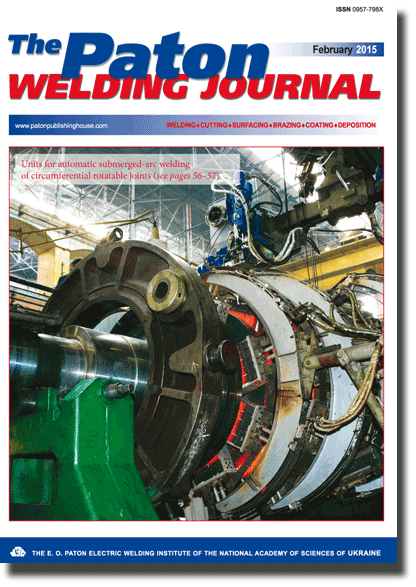| 2015 №02 (01) |
DOI of Article 10.15407/tpwj2015.02.02 |
2015 №02 (03) |

The Paton Welding Journal, 2015, #2, 7-13 pages
EFFECT OF WELDING THERMAL CYCLE ON STRUCTURE-PHASE TRANSFORMATIONS AND PROPERTIES OF HAZ METAL OF ALLOYED 30Kh2N2MF TYPE MEDIUM-CARBON STEEL
V.D. Poznyakov, V.A. Kostin, A.A. Gajvoronsky, I.A. Mossokovskaya, V.V. Zhukov And A.V. Klapatyuk
E.O. Paton Electric Welding Institute, NASU. 11 Bozhenko Str., 03680, Kiev, Ukraine. E-mail: office@paton.kiev.ua
Abstract
Thermostrengthened alloyed medium-carbon and carbon steels of average, increased and high hardness are widely used in manufacture of welded metal structures for car bodies. HAZ metal should also have corresponding values of yield strength considering the requirements necessary for providing of welded joint full-strength. However, mechanical properties of HAZ metal obtained by means of formation of specific complex of microstructures, generated in process of its cooling (welding modes), in contrast to steel, which acquires necessary complex of mechanical properties as a result of initial heat treatment (quenching and tempering). Preferred formation of martensite structures in HAZ metal of welded joints from given steels and saturation of this area by diffusible hydrogen result in increase of their susceptibility to cold crack formation. In this connection, this work represents the results of investigations aimed at study of effect of welding thermal cycles on nature of structural transformations, hardness, static strength and cold crack resistance of HAZ metal of high-strength alloyed medium-carbon steel of the 30Kh2N2MF type with 0.31 and 0.36 % carbon content. Structure and kinetics of transformation of undercooled austenite was investigated using current methods of physical materials science by means of simulation of phase transformations on Gleeble 3800 machine. It is determined that austenite decomposition in the samples of 30Kh2N2MF steel HAZ, independent on carbon content in it, takes place mainly in area of martensite transformation at cooling rate w6/5= 2.5-30 °C/s. It is shown that hardness and static strength of HAZ metal in steel with 0.36%C are provided for the whole studied range of cooling rates. Similar properties of HAZ metal in steel with 0.31 % C can be achieved under condition of cooling at 600-500 °C and rate not less than 10°C/s. The results of investigations can be used for optimizing welding modes of special equipment and further improvement of modes of steel heat treatment. 15 Ref., 4 Tables, 7 Figures.
Keywords: high-strength alloyed steels, heat-affected zone, welding thermal cycles, CCT diagram of austenite decomposition, metal structure, metal hardness
Received: 17.12.14
Published: 01.04.15
References
1. Tolten, G.T. (2006) Steel heat treatment: Metallurgy and technologies. Front cover. CRC Press (Technology & Engineering).
2. Kashirsky, Yu.V., Koloskov, M.M. (2000) Information bank on machine building materials and processing modes. Tyazh. Mashinostroenie, 4, 12-19.
3. Goldshtejn, M.I., Grachev, S.V., Veksler, Yu.G. (1985) Special steels: Manual for higher education institutions. Moscow: Metallurgiya.
4. Bolshakov, V.I., Dolzhenkov, I.E., Dolzhenkov, V.I. (2002) Technology of heat and combined treatment of metal products: Manual for higher education institutions. Dnepropetrovsk: Gaudeamus.
5. Kuchuk-Yatsenko, S.I., Grigorenko, G.M., Novikova, D.P. et al. (2007) Effect of energy input on ductile properties of flash butt welded joints in steel X70. The Paton Welding J., 6, 2-6.
6. Medovar, L.B., Saenko, V.Ya., Polishko, A.A. et al. (2010) Effect of ESC LM thermal cycle on structure of model multilayer ingot. Zbirnyk Nauk. Prats MUSB, 1, 75-83.
7. Seo, J.S., Kim, H.J., Ryoo, H.S. (2008) Microstructure parameter controlling weld metal cold cracking. J. Achievements in Materials and Manufact. Eng., 27(Issue 2), 199-202.
8. Sterenbogen, Yu.A. (1986) Some factors determining the resistance of HAZ metal of martensitic steels to cold cracking. Avtomatich. Svarka, 6, 5-8.
9. Skulsky, V.Yu. (2009) Peculiarities of kinetics of delayed fracture of welded joints of hardening steels. The Paton Welding J., 7, 12-17.
10. Gajvoronsky, A.A., Sarzhevsky, V.A., Gordonny, V.G. (1997) Weldability of medium-carbon alloyed steel 38Kh2MYuA. Avtomatich. Svarka, 4, 20-24, 33.
11. Li, S., Akiyama, E., Yuuji, K. et al. (2010) Hydrogen embrittlement property of a 1700 MPa class ultrahigh strength tempered martensitic steel. Sci. and Technol. Adv. Materials, 11, 1-6. https://doi.org/10.1088/1468-6996/11/2/025005
12. Wongpanya, P., Boellinghaus, Th., Lothongkum, G. (2008) Heat treatment procedures for hydrogen assisted cold cracking avoidance in S1100 QL steel root welds. Welding in the World, 52, 671-678.
13. Grigorenko, G.M., Kostin, V.A., Orlovsky, V.Yu. (2008) Current capabilities of simulation of austenite transformations in low-alloyed steel welds. The Paton Welding J., 3, 22-24.
14. Cherepin, V.T. (1968) Experimental technique in physical metals science. Kiev: Tekhnika.
15. Makarov, E.L. (1981) Cold cracks in welding of alloyed steels. Moscow: Mashinostroenie.
Suggested Citation
V.D. Poznyakov, V.A. Kostin, A.A. Gajvoronsky, I.A. Mossokovskaya, V.V. Zhukov And A.V. Klapatyuk (2015) Effect of welding thermal cycle on structure-phase transformations and properties of haz metal of alloyed 30Kh2N2MF type medium-carbon steel. The Paton Welding J., 02, 7-13.The cost of subscription/purchase order journals or individual articles
| Journal/Currency | Annual Set | 1 issue printed |
1 issue |
one article |
| TPWJ/USD | 384 $ | 32 $ | 26 $ | 13 $ |
| TPWJ/EUR | 348 € | 29 € | 24 € | 12 € |
| TPWJ/UAH | 7200 UAH | 600 UAH | 600 UAH | 280 UAH |
| AS/UAH | 1800 UAH | 300 UAH | 300 UAH | 150 UAH |
| AS/USD | 192 $ | 32 $ | 26 $ | 13 $ |
| AS/EUR | 180 € | 30 € | 25 € | 12 € |
| SEM/UAH | 1200 UAH | 300 UAH | 300 UAH | 150 UAH |
| SEM/USD | 128 $ | 32 $ | 26 $ | 13 $ |
| SEM/EUR | 120 € | 30 € | 25 € | 12 € |
| TDNK/UAH | 1200 UAH | 300 UAH | 300 UAH | 150 UAH |
| TDNK/USD | 128 $ | 32 $ | 26 $ | 13 $ |
| TDNK/EUR | 120 € | 30 € | 25 € | 15 € |
AS = «Automatic Welding» - 6 issues per year;
TPWJ = «PATON WELDING JOURNAL» - 12 issues per year;
SEM = «Electrometallurgy Today» - 4 issues per year;
TDNK = «Technical Diagnostics and Non-Destructive Testing» - 4 issues per year.


